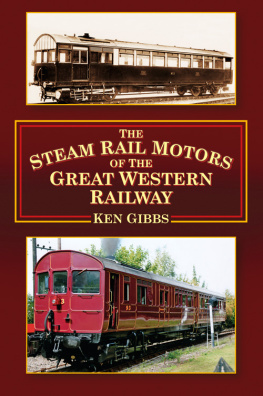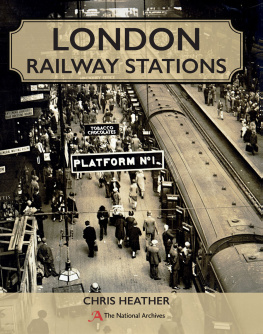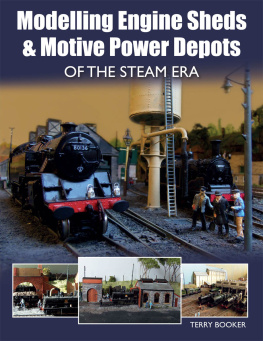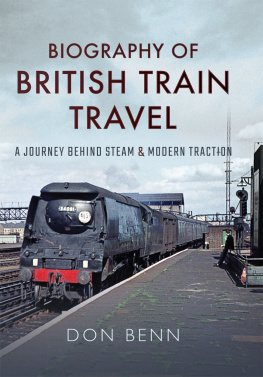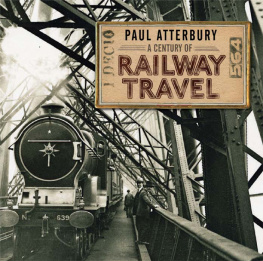
To all Craftsmen in Steam.
In grateful memory of those past, in support of
those present, and with every good wish for those
yet to come (and come they will!)
Contents
During my Great Western years, many friendships and contacts were made, and over the years some have fallen away whilst others have been maintained. This compilation of Steam Workshops of the Great Western has seen the reinforcement of old friendships and the renewal of some lost for a long period. New contacts have been made, and from many directions assistance has been afforded from old and new sources, with a notebook from here and a piece of paper from there, all coming together in this presentation of Steam Workshops of the Great Western Railway .
For omissions I can only apologise, but a great deal which has appeared, whether forms, photos or drawings, has sprung from many sources, and from odd items stored as souvenirs for many years by many people. Many now, like the author, are in their eighties! And some are no longer with us. Sincere thanks to all.
Ken Gibbs
LCGI (Mech. Eng.)
2014
In my book The Great Western Railway How it Grew , I introduced the reader to the constituent companies absorbed, developed, altered or put out of business by the expanding Great Western Railway (GWR). Included were details of the locomotive stocks affected by the takeover and the modifications using, where appropriate, standard Great Western fittings.
This book explains those notes with details of the locomotive maintenance and building facilities which came with, or were developed from or for the maintenance, building or rebuilding of those locomotives. The main GWR workshops at Swindon have been covered many times (but are included briefly here for continuity), whilst other facilities are rarely, if ever, mentioned in detail. It is intended that this book will fill a blank space in the current railway literature range, which already covers goods sheds and goods yards, along with running sheds, railway station architecture and civil engineering bridges, viaducts, etc.
Many of the buildings have now, taking Swindon as an example, been developed into shopping malls and commercial areas, or have disappeared in a cloud of demolition dust, as has Swindons mighty 11.5-acre A Shop steam locomotive repair and maintenance complex. One remaining original workshop (the old R machine and fitting shop) now houses STEAM, the Museum of the Great Western Railway.
At other sites on the system, a number of the lesser workshops have survived, and have become part of the preserved/heritage railway scene, now in use for really far more than they were originally designed in the formative years, staffed usually by unpaid volunteers and railway enthusiasts.
These shops are often now accompanied by new or refurbished buildings housing the maintenance and rebuilding of the heritage carriage and wagon rolling stock, completing the total railway aspect.
At Swindon, this portion of the works was abandoned in 1964 and the maintenance of C & W stock combined and transferred to the locomotive workshops, now greatly reduced from the original layout, the whole ending in 1987 when the works closed. The remains are now a shopping mall and museum.
This book thus outlines the story and history of the founding, development, growth and eventual fate of the workshops associated with the development and demise of the GWR in its steam years.
Ken Gibbs

Thumbnail Sketches of Main Works and Facilities
From the early days, the proliferation of railways indicated very rapidly a missing ingredient in their make-up. Lines were laid to approved routes, locomotives and running stock obtained, finances (sometimes!) well organised, schedules for passenger and goods traffic arranged. And then arose maintenance!
Having got the stock, the day-to-day running could be covered (the driver could always nip around with his long-spouted oil can!), but for deeper maintenance other facilities would be required. For the very heavy repairs there was always the manufacturer, but for general routine maintenance it seems the general philosophy was that if it was ignored, a problem would go away. Nothing really changes. Even today maintenance is one of the least acceptable expenses.
In the early days, the problems were certainly worse, in that few could do the craft work, and often there was nowhere to actually work anyway. It was with some companies often with great reluctance that even the engine shed was built, let alone workshops, and there are on record several instances of locos being shedded under bridges and station canopies. Maintenance was pushed under the nearest stone in the hope that it would disappear, but of course it couldnt and wouldnt. It was an essential part of the railway system.
There is, of course, the now famous legend of both Brunel and Gooch working in the running shed at the London end of the Great Western line, in the attempt to improve the efficiency and reliability of the first locomotives. This introduces an additional requirement, coming under the heading of design rather than repairs and maintenance, and particularly in the early years complicating the routine essentials. A component had to be made to work effectively, being altered if required, before its regular maintenance could begin.
Even with the Great Western, taking the famous North Star as an example, the loco was delivered at Maidenhead in kit form several months before the running shed was built, probably around it, in 1838. The loco had been temporarily stored, and we can visualise it sheeted down against the weather on a short length of track, as the connection from delivery barge to main line was not possible at that time. The main line had not reached the area.
At the London Paddington end, a two-part shed consisted of a stabling end and a workshop end, in which heavier repairs and maintenance could be done, branching in two directions from a central octagonal roundhouse with a turntable. Once again, the locos were available before the covered facilities, so that the first attempts at maintenance were done in the open air. An adjacent workshop facility was later built to enable the roundhouse building to be utilised wholly as a shed.
As the line progressed, so sheds, some temporary, were constructed to house the locomotive stock. In some instances, where there would not be the future requirement for a permanent running shed, a length of siding was constructed. One such siding (within a mile of where this book is currently being written), was at Hay Lane, just outside Swindon, the terminus of the Great Western line for about six months in 1840.
Hay Lane, just a spot on a country road between Swindon and Royal Wootton Bassett, actually had a canal wharf on the Wiltshire and Berkshire Canal en route through the valley below Swindon. This was probably the attraction as a ready-made supply point at the lines temporary end. Although still known as Hay Lane Wharf, it now takes an old Swindonian to point out the course of the long-gone canal, which is now part of a restoration programme.
There is no record of any form of running shed at Hay Lane, at this or any other period, but just back up the line the Great Western Workshops would be set out, with their own running shed, at roughly the topographical halfway point of the envisaged LondonBristol Railway. Brunel and Gooch were off the mark very quickly with regard to the building and maintenance potential for future Great Western steam. At Swindon, as at Paddington, it is more than likely that the shed and facilities were in use really before they finished construction, the finishing touches progressing around and above the locomotives.
Next page

